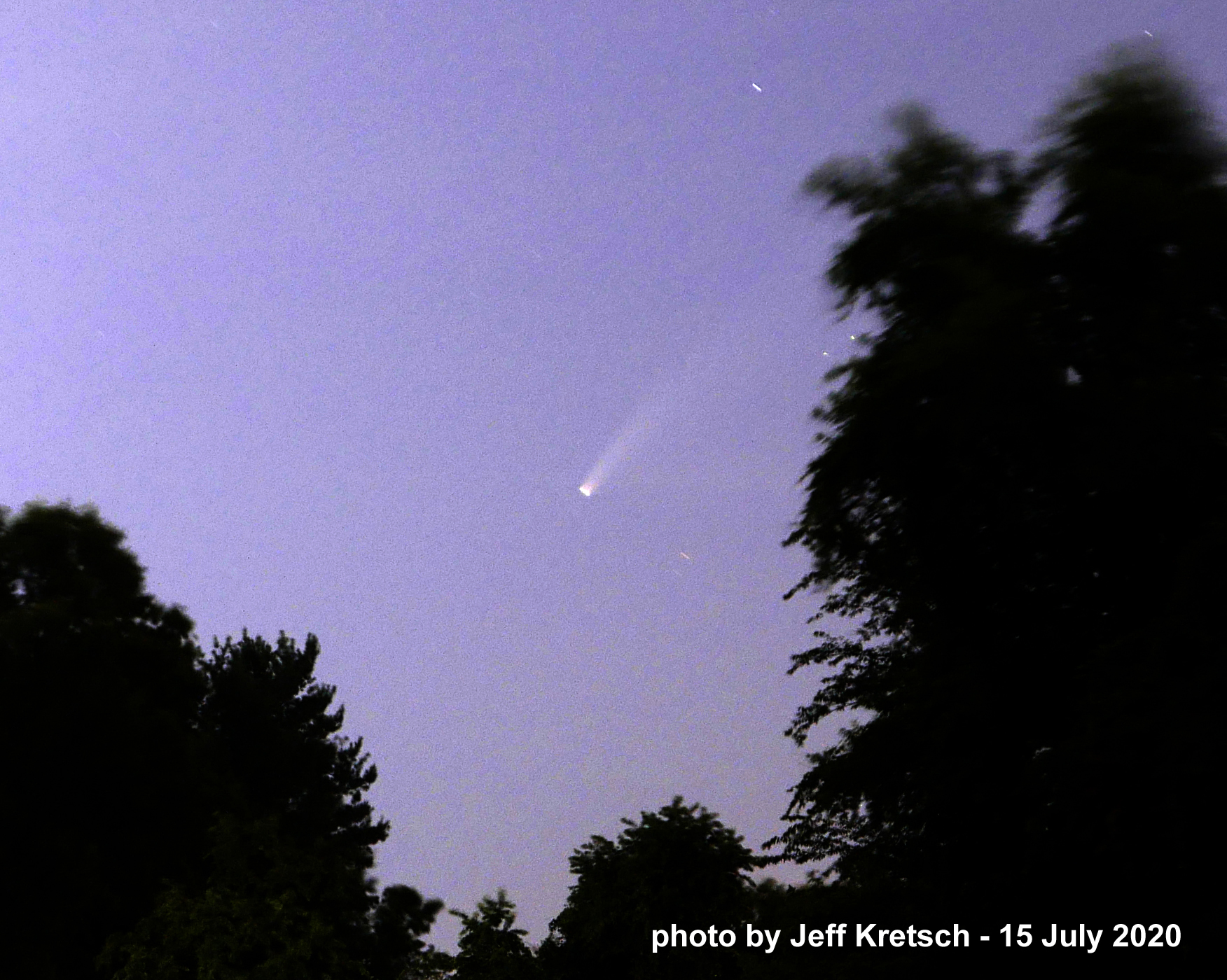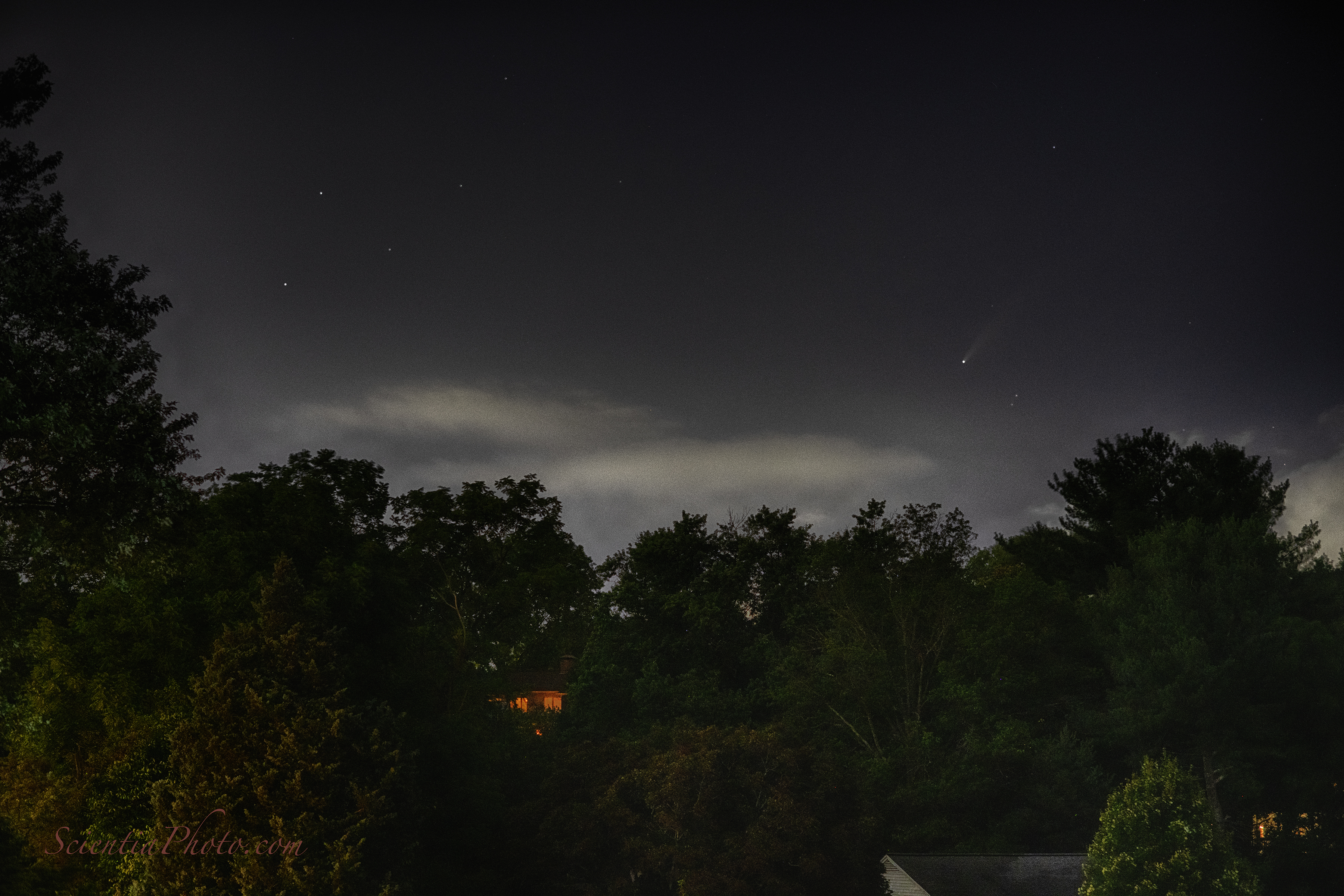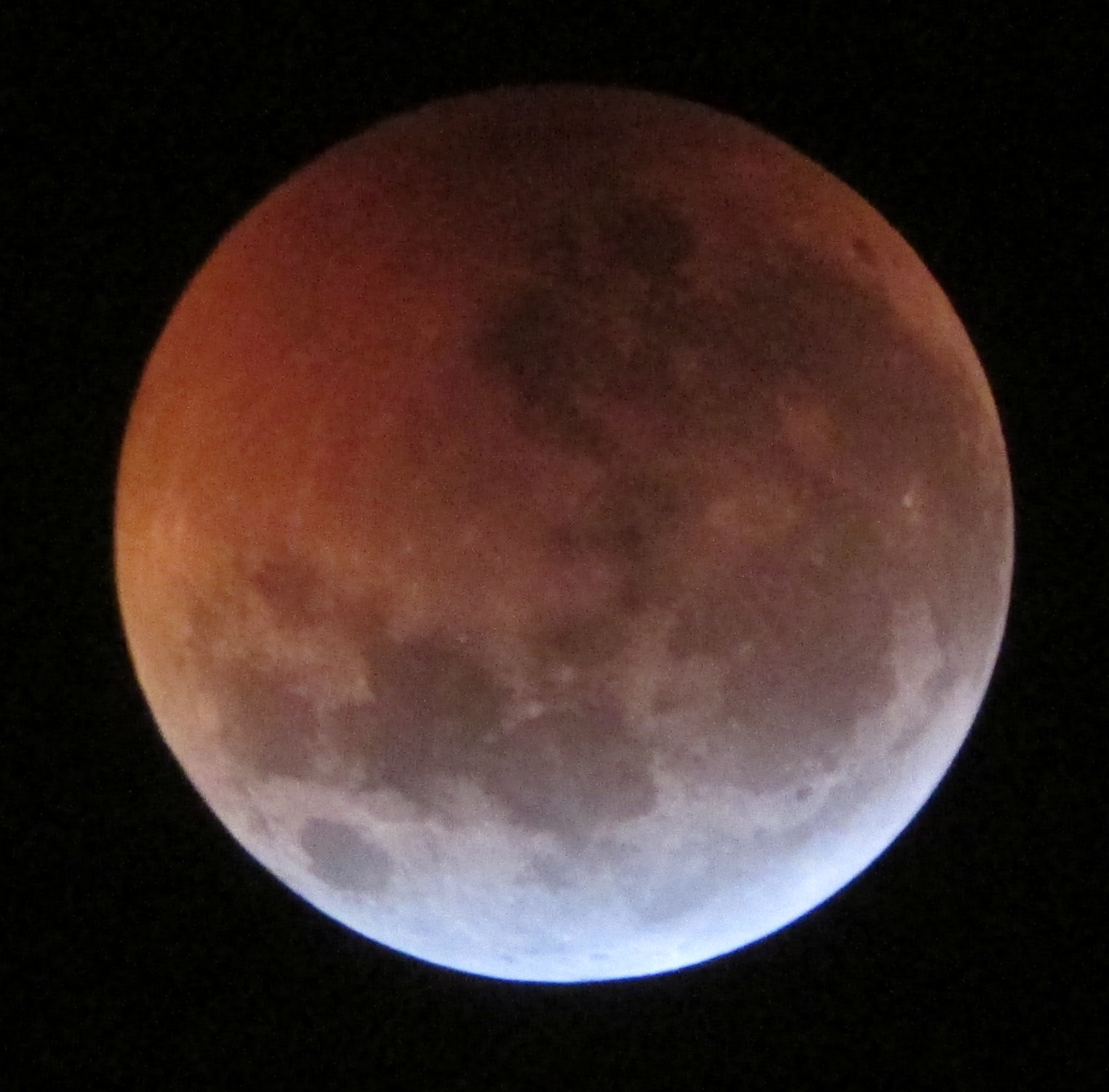- Details
- Category: Astronomical Events
 What a difference several days make. Comet Neowise can now be seen in the northwest evening sky an hour or so after sunset. It is low to the horizon, but each night it will climb about 2 degrees higher. On the night of July 15th Dr. Jeff Kretsch took the ajoining photo and wrote, "I had a decent site from a hill overlooking the northwest, and about as good of conditions for summertime as I could hope for. Others saw it before I did and pointed out where to find it. Once I did it stood out quite well in binoculars, and I could just detect it visually. It remained visible from about 9:40 PM when we first saw it until around 10:00 PM when it sank into the haze. It was higher than I expected it would be. It gains 2 degrees a night, but the weather forecasts are deteriorating after tonight."
What a difference several days make. Comet Neowise can now be seen in the northwest evening sky an hour or so after sunset. It is low to the horizon, but each night it will climb about 2 degrees higher. On the night of July 15th Dr. Jeff Kretsch took the ajoining photo and wrote, "I had a decent site from a hill overlooking the northwest, and about as good of conditions for summertime as I could hope for. Others saw it before I did and pointed out where to find it. Once I did it stood out quite well in binoculars, and I could just detect it visually. It remained visible from about 9:40 PM when we first saw it until around 10:00 PM when it sank into the haze. It was higher than I expected it would be. It gains 2 degrees a night, but the weather forecasts are deteriorating after tonight."
Dr. Bob Murphy of Timonium, MD is a retired astronomer who has turned to scientific and astronomical photography. You can find his photographs at: https://www.scientiaphoto.com/Aeronautics-Space/Astrophotography-2018/
Here is his story about taking photos of the comet, starting in when the comet was visible in the early morning and as it moved to the evening sky he "...failed to see it last night at the sane hour of 8:45PM... Finally! Some success at capturing the comet. What a gorgeous sight! This is my third night of shooting. Some of you have seen my earlier struggles, while others have been spared the inferior photographs, and technical grumblings."
 [At right is his photograph of the comet on the evening of 14 July 2020]
[At right is his photograph of the comet on the evening of 14 July 2020]
"This has to count as an artistic rendering rather than a mere photograph. Too much has been done to make it work. Maybe if I had the eyes of a twenty-something and the knowledge of what it is supposed to look like of a seventy-something I could have seen it like this. Oh! Wait. That’s what happened - sort of."
- Details
- Category: Astronomical Events
 Comet C/2020 F3 (NEOWISE) is putting on quite a show along the northeastern skyline in the early morning. One estimate says it is currently at visual mag 2, while others say closer to 1. Whichever, Fred Espenak posted that it is our brightest comet for us to observe in two decades.
Comet C/2020 F3 (NEOWISE) is putting on quite a show along the northeastern skyline in the early morning. One estimate says it is currently at visual mag 2, while others say closer to 1. Whichever, Fred Espenak posted that it is our brightest comet for us to observe in two decades.
On the morning of 8 July 2020 with clear skies in the Great Falls region of Maryland and Virginia Jeff Kretsch took the photo shown here with the head and tail of Comet Neowise clearly visible in the morning twilight. Suggest a 2-4 second exposure.
Bill Burton had a nice view of the comet using 10x40 binoculars. He went to a local golf course to het a good view of the horizon. "Small bright coma with narrow wedge-shaped dust tail going straight up with a plasma tail on left edge of the dust tail..."
The Sky Guide shows it will be 10 degrees altitude at 48 degrees azimuth (northeast) at 5 am EDT tomorrow (and 14 degrees altitude, 52 degrees azimuth at 5:30 am.). Sunrise is at 5:51 am on the horizon at 60 degrees azimuth.
 A close-up of the comet at right is provided by Jeff Kretsch taken the morning of July 10th. "I was able to see the comet visually at Country Side in Sterling VA. I carried my Celestron to a point where I got a horizon view, wasn't able to carry my tripod too - age catching up with me. So the wide angle has a lot of jitter but it shows nearly the visual appearance. I first visually saw the tail like a dim searchlight pointing straight up before getting the nucleus. This is a very nice comet."
A close-up of the comet at right is provided by Jeff Kretsch taken the morning of July 10th. "I was able to see the comet visually at Country Side in Sterling VA. I carried my Celestron to a point where I got a horizon view, wasn't able to carry my tripod too - age catching up with me. So the wide angle has a lot of jitter but it shows nearly the visual appearance. I first visually saw the tail like a dim searchlight pointing straight up before getting the nucleus. This is a very nice comet."
Clouds are the biggest hazzard to viewing the comet in the Washington DC, Virginia, and Maryland local area. Bob Gardner from the North Virginia Astronomical Club (NOVAC) reported on the morning of the10th, "I saw the comet in binoculars from Luria Park in Falls Church, VA this morning, but clouds were a much bigger problem today than yesterday. I could see the comet through thin clouds intermittently, but it was covered by thicker clouds most of the time. Frustrating because the rest of the sky was clear."
- Details
- Category: Astronomical Events
 The Parktakes Transit of Mercury Celebration occured at Observatory Park on Veterans Day 11 Nov 2019. Activities were run by the Fairfax County Park Authority staff and the Analemma Society. Mary Blessing had a group of her astronomy & geosystem students come in the morning before the public arrived to help set up and act as additional volunteers.
The Parktakes Transit of Mercury Celebration occured at Observatory Park on Veterans Day 11 Nov 2019. Activities were run by the Fairfax County Park Authority staff and the Analemma Society. Mary Blessing had a group of her astronomy & geosystem students come in the morning before the public arrived to help set up and act as additional volunteers.
More than 35 people came to view the tiny speck of Mercury cross the image of the sun using special telescopes to insure eye safety. The main viewing was done with an Analemma Society Coronado solar telescope fitted with a Hydrogen Alpha filter. George Bradwhaw took photos of third contact (C3) with Mercury leaving the sun. He used a Tamron 150-600mm lens with a Thousand Oaks filter attached to a Canon 70D mounted on a ball head tripod. Kaushik Nagarkar used both his AstroPhysics Refractor and then used fellow AS member James Nguyen's Stellarview 102 mm aperature using a Nikon d7500 without T-Ring. Go to Gallery/Astronomical Gallery and look at photos #3, #4, and #5.
- Details
- Category: Astronomical Events
Special Event: Total Lunar Eclipse Viewing Night
 Lunar Eclipse Viewing at Turner Farm, Observatory Park has been canceled due to extremely cold weather.
Lunar Eclipse Viewing at Turner Farm, Observatory Park has been canceled due to extremely cold weather.
Sun 9:30pm - 1am Jan 20 2019: Come experience the total lunar eclipse of the night of January 20 at the Turner Farm Park roll-top observatory. Enjoy a campfire, marshmallow roasting, and constellation viewing as well. See close-up views of the Moon as it is eclipsed by the earth through telescopes in the Roll-Top Observatory, While you're there, catch a telescopic vierw of Mars, and have a look at beautiful star clusters.
Observator Park at Turner Farm will stay open to the end of the eclipse. For more information, see www.analemma.org. Event subject to cancellation due to weather and cloudy conditions. Park opens at 9:30 PM, Sunday, January 20.
In spite of the cold weather and the cancellation of viewing at Turner Farm, Bill Burton and Don Fowler, both of the Analemma Society, took hand-held shots of the moon with their camera. Bill's photo is posted at right. He says, "I stayed close to home--50 ft from my front door in the lee of a row of townhouses--and set up my portable Orion 8-inch reflector in the parking lot. This is a handheld shot through the eyepiece, with a non-SLR camera. Even with chemical handwarmers, my warmest down coat, and Sorel boots, I had to come in a couple times during totality to warm up."
January 20-21, 2019 Lunar Eclipse Times
---------------------------------------------------------
Penumbral Eclipse begins: 9:36 PM ET
Partial Eclipse begins: 10:33 PM ET
Full Eclipse begins: 11:41 PM ET
Maximum Eclipse: 12:12 AM ET
Full Eclipse ends: 12:43 AM ET
Partial Eclipse ends: 1:50 AM ET
Penumbral Eclipse ends: 2:48 AM ET
- Details
- Category: Astronomical Events
 NEW ANNOUNCEMENT ABOUT VIEWING THE PERSEIDS
NEW ANNOUNCEMENT ABOUT VIEWING THE PERSEIDS
The Analemma Society will open Turner Farm Observatory Park Saturday, August 11 for public observing of the Perseids meteor shower. Hours are 9 PM to 2 AM.
However, if we get rain or solid clouds, we will likely close early. Check for status updates at our @AnalemmaSociety twitter account (accessible on the website under Tweets).
The Analemmal Society will NOT open Turner Farm Park for public observing of the meteor shower on Sunday night, August 12.
Meteor showers are best viewed with your unaided eyes lying in a lawn chair wrapped in a blanket or sleeping bag to stay warm. At Observatory Park we will have a meteor expert on hand to explain what you're viewing and how best to observe (any direction and halfway between the horizon and zenith). The Perseids are visible all night long with maximum rates occurring after midnight.
On Sunday August 12th, a one hour meteor class is scheduled for 8PM at Observatory Park at the Roll-Top Observatory. This class sponsored by Fairfax County Parktakes and requires a small fee. Those interested can sign up for it on the Fairfax County Parktakes website (https://www.fairfaxcounty.gov/parks/turner-farm/events). Search for "meteor" under "science and technology" at "TurnerFarmPk". The class limit is 24 persons, so sign up early.
The Perseid Meteor Shower is an annual event when the earth's orbit around the sun plows through debris left by comet Swift-Tuttle. The date is around mid-August, varying between the 11th and 13th. The NASA video below was for the year 2015 when the best viewing occurred on August 12/13. This year Perseid meteor shower will reach its maximum rate of activity on 13 August 2018. Both nights of Saturday Aug 11/12 and Sunday Aug 12/13 are ideal for watching the meteors. This is a great year to watch the Perseid meteors as the moon is only a small waxing cresent after sunset ... well before midnight when we'll see the best display.
Page 6 of 7

